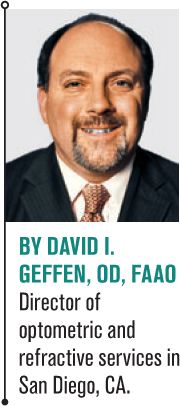R&D needed for new gas perm care systems, materials
Where is the research and development in care systems for these patients? Where is the development of new gas permeable materials?

Within the contact lens world, there has been a great shift toward the use of large-diameter rigid gas permeable lenses. Scleral and semi-scleral lenses are rapidly become the standard for use with corneal irregularities such as keratoconus, pellucid marginal degeneration, corneal transplants, and most any other irregular topography. There are many independent laboratories providing us with unique designs, enabling us to enhance the lives of many patients. However, with this advancement in lens design, there is a dramatic duo of forgotten items. Where is the research and development in care systems for these patients? Where is the development of new gas permeable materials?
Gas permeable contact lenses: Here to stay?
Mismatched care systems and lenses
Unfortunately, the smaller independent lab cannot make the necessary investment to get through the FDA approval process for a new care system. It seems that the larger manufacturers do not see enough profit to continue to invest in this area directly. This leaves the practitioner to sort through a hodgepodge of older approved gas permeable solutions or approved soft lens solutions. So most doctors have resorted to going with off-label use of many cleaners, disinfectants, and tears.

Through trial and error, we have found that currently available gas permeable wetting solutions cannot be used with these large diameter lenses. The large size of the lens reduces the tear interchange. If we wet the lens with an available gas permeable wetting system, we trap that solution under the lens with its preservatives and typically see corneal staining and comfort problems. So, many of us started to use our soft lens multi-purpose care systems to wet the lenses but once again found many patients end up with comfort problems. I have now switched to using non-preserved tears as my wetting agent for all my larger diameter gas perm patients. With many of our newer lenses coated the older abrasive cleaning systems are no longer appropriate as they end up scratching the surface and cause unwettable lenses. So, I have switched to using peroxide care systems to disinfect and clean my patient’s larger diameter gas perms.
Why peroxide is still a good choice for lens care
Appeal to manufacturers
Now, we get to the point of this month’s department; I am making an appeal to the larger manufacturers to look at this growing market and use some of the amazing technological advancements you have made in soft lens care systems and invest some time and money into providing us with some better systems for our gas permeable lens wearers. This market may be smaller than the soft lens market, but it is not threatened by daily disposables, and these patients are not likely to have a surgical procedure to avoid wearing contact lenses. These patients need to wear their gas permeable lenses full time. They need them because most cannot see with most any other type of correction. They are our most loyal patients, and they will be your most loyal customers. That is my soapbox for this month. I look forward to hearing from you.